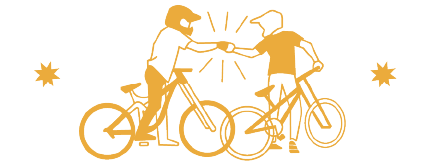
Blog

How to Ride Steep MTB Features | Mountain Bike Stability Tips from Ben Lomond Trails
Riding steep terrain can feel intimidating even for experienced riders but it doesn’t have to be. In this blog, Piyush from Treadmark breaks down how to stay stable and in control on steep MTB features using simple, timed body movements and position shifts.
The key takeaway? It’s not about leaning back or just bracing - it's about being dynamic in relation to the Gradient change.
A practical “cone crush” drill is also introduced, helping riders build muscle memory and timing by placing a cone where the trail flattens—and challenging themselves to crush it as they exit the steep. This teaches commitment to staying low through the full descent.
Whether you’re riding Queenstown’s Ben Lomond trails or tackling techy lines elsewhere, this post will give you the confidence to handle steeps with purpose and precision.

Anatomy of drops: What actually goes on, covering standard technique and a variation.
In this TechTalk session, Piyush from Treadmark MTB Coaching breaks down the real technique behind riding mountain bike drops safely, smoothly, and with control. Filmed on the iconic Buckland trail in Queenstown’s 7 Mile network, this video and blog combo focuses on one critical concept: the zone of compression.
Using red cones to mark the space just before takeoff, Piyush explains how to compress through the feet to load energy into the bike. This compression isn’t just about getting low—it’s about building pressure through the core, hips, and pedals to give you control, balance, and traction. Without it, your front wheel will drop early, risking nose-heavy landings.
As the bike rolls through the lip, Piyush demonstrates how to release that pressure and use the resulting lightness to guide the bike towards the landing.
On steeper terrain, like the Tree Drop on Buckland, the movement becomes more dynamic, combining, getting low for the steeper gradient, compression with a well-timed front wheel lift.
This blog is essential reading for riders learning to navigate drops with confidence. Whether you’re hitting your first drop or dialing in technique for technical step-downs, this video and blog breaks it down clearly and practically.

Think dropping your outside foot is always right? The surprising truth about cornering and the technique that could transform your riding.
Cornering is one of the most critical—and misunderstood—skills in mountain biking. In this blog, Piyush from Treadmark dives deep into the technique of dropping the outside foot in corners, breaking down when it helps, when it doesn’t, and how to use it effectively. Using a simple cone-marked corner setup, P tests three approaches: keeping pedals level, fully dropping the outside foot, and a third method using what he calls the “Tip and Twist” technique—where the bike is tipped underneath while the body rotates through the turn, with the outside foot dropping only as needed.
The results were clear: adaptive foot drop, paired with dynamic body movement, offers the best mix of traction, maneuverability, and line control. Instead of sticking rigidly to one method, riders are encouraged to stay flexible and respond to the trail in real-time.
Whether you're struggling with over-leaning, inconsistent exits, or just want to corner smoother and faster, this blog offers practical drills, a visual technique table, and a simple framework to build confidence in any turn. A must-read for riders looking to level up their skills and ride with more flow.
